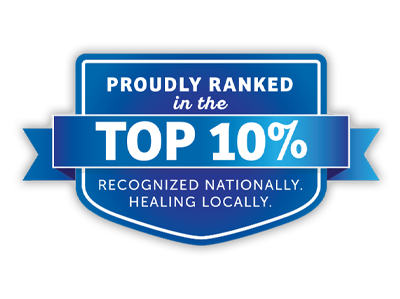About Us
We provide specialized rehabilitative services to our patients in the communities we serve. We often see patients who are recovering from disabilities caused by injuries, illnesses, or chronic medical conditions.
Why Rehabilitative Care?
National research shows that inpatient rehabilitative care is significant to a patient’s healing process, often helping patients regain or improve productivity and independence.
Better Long-Term Results
Patients treated in inpatient rehabilitation facilities have better long-term results than those treated in skilled nursing facilities, according to a study commissioned by the ARA Research Institute, an affiliate of the American Medical Rehabilitation Providers Association.
The study compared more than 100,000 medically and demographically similar patients in inpatient rehabilitation facilities to patients in skilled nursing facilities during a two-year period.
The study shows that patients who receive rehabilitation services in inpatient facilities have improved quality of life. Improved quality of life is defined as patients living longer, reduced use of facility-based care such as hospital and ER visits, and the ability for patients to remain in their homes without additional outpatient services.
Patients treated at inpatient rehabilitation facilities:
- Returned home from their initial stay two weeks earlier
- Remained home nearly two months longer
- Stayed alive nearly two months longer
In addition, these patients experienced an 8% lower mortality rate and 5% few emergency room visits per year.
Better for Stroke Recovery
The American Heart Association/American Stroke Association released guidelines strongly recommending that stroke patients be treated at inpatient rehabilitation facilities rather than skilled nursing facilities.
Many people survive strokes with some level of disability. The guidelines highlight the effective and important aspects of rehabilitation from an inpatient rehabilitation facility, including:
- Patients participate in at least 3 hours of rehabilitation a day from physical therapists, occupational therapists, and speech pathologists
- Nurses are continuously available
- Doctors typically visit daily
The guidelines advocate for patients to go to inpatient rehabilitation hospitals because there is considerable evidence that patients benefit from the team approach in facilities that understand the importance of rehabilitation during the early period after a stroke.
For a person to fulfill their full potential after a stroke, there needs to be a coordinated effort and ongoing communication between a team of professionals as well as the patient, family and caregivers.
Top 10%
Recognized in the Nation’s Top 10%
Mountain Valley Regional Rehabilitation Hospital has been ranked by the Uniform Data System for Medical Rehabilitation (UDSMR), a non-for-profit corporation that was developed with support from the National Institute on Disability and Rehabilitation research, a component of the U.S. Department of Education. It ranks rehabilitation facilities based upon care that is patient-centered, effective, efficient, and timely.
Through UDSMR, our hospitals collaborate with our peers throughout the United States to share information and establish best practices for patients. This helps us elevate rehabilitative care for everyone across the United States.




